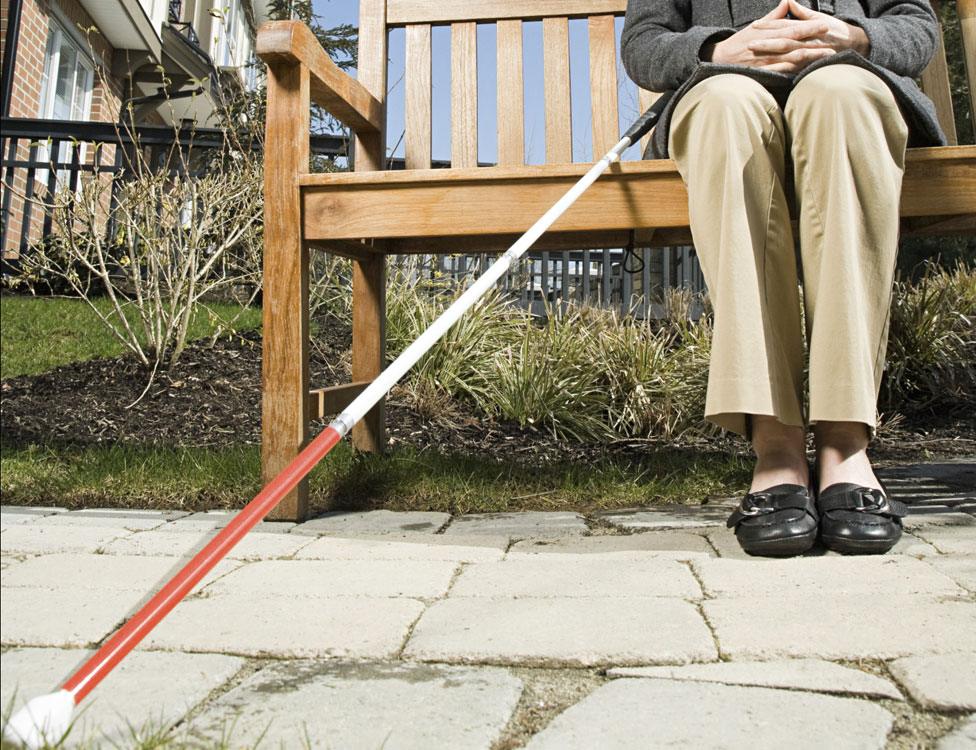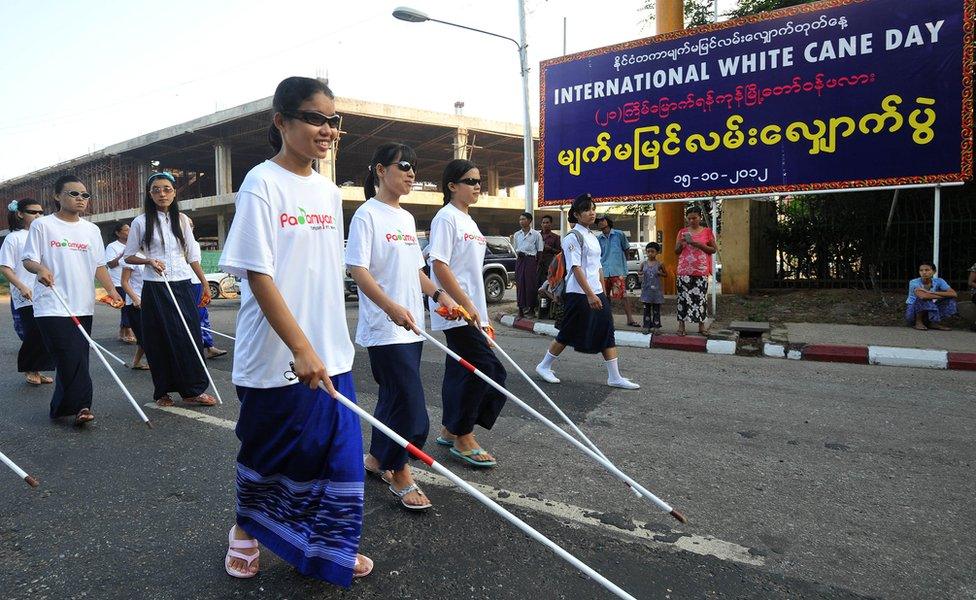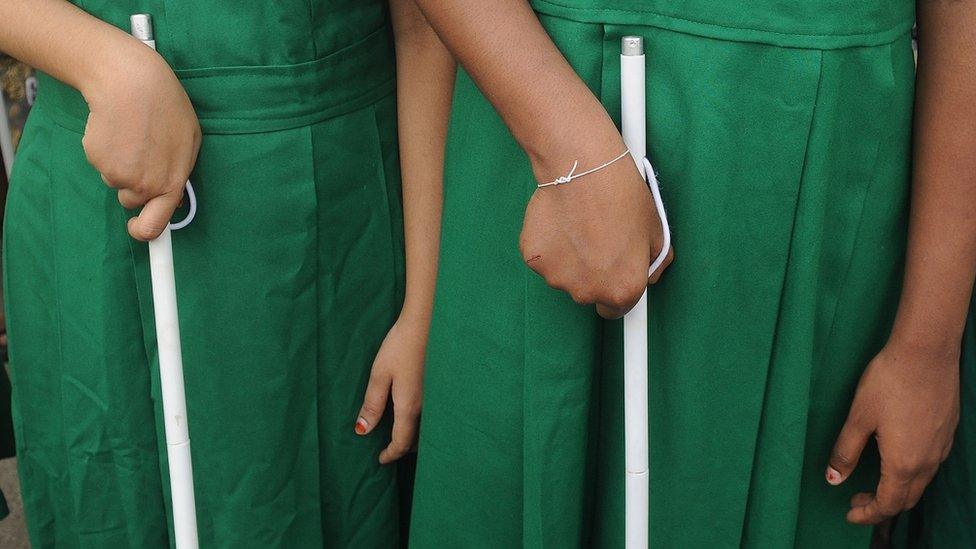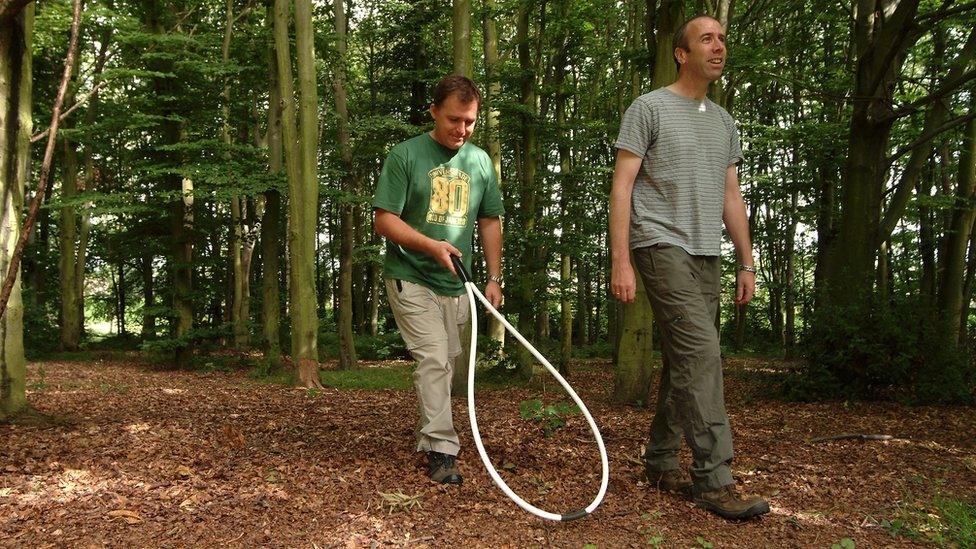How dangerous are white canes?
- Published

A blind schoolgirl has been asked to stop using her white cane in school due to health and safety concerns. But could they be dangerous, asks blind BBC journalist Damon Rose.
Lily-Grace Hooper, a seven-year-old school girl from Bristol, has been told by her school not to use her white cane because it could trip up teachers and other pupils. Her mother, Kristy, has said she is "devastated" but the school's mobility officer had raised health and safety reasons and so the decision was made. Lily-Grace would have to leave her cane at home.
The school have stressed the measure was a temporary one while the situation was discussed with the family.
What is a white cane?
It's not a white walking stick as many believe because you don't lean on it, instead you hold it loosely in your hand and move it from side to side to scan what is in front of you. But it is white and comes in several varieties. There are guide canes, symbol canes and long canes. And they have changeable tips at the end depending on the surfaces you regularly walk on. (Mushroom tip, anyone?)
Did you say "long" canes?
Yes. These are the professional cane if you like, your solid, classic, serious walker kind of cane. And they are indeed long. The ideal cane would reach all the way up to your sternum in fact, so they could be as long as 5ft for a 6ft tall person, for instance. This means they can stick out a long way in front of the person using it.

Some canes can be very long
The way they work is simple. Proper. Basic. Simple. If the cane hits something then you know "something" is there. It gives an advanced warning before crashing into it. You can then readjust your stride and carry on walking around it, if you can.
If you get a jarring thwack reverberating up your arm and into your shoulder indicating something big in front of you like a car or a bench, you might want to stop and navigate around it with a little extra care before attempting to continue in a straight line. Guide dog owners have been known to think of them as a bit undignified because of all this stop-start jarring but practiced users can learn to use it elegantly.
The reason they are white is not to help the blind person directly, it is a symbol for sighted people to take care around the person carrying it, or offer assistance.
Do white canes cause accidents, then?
Amie Slavin in Lincoln is a regular white cane user. "I've done lots of small things, I've tapped people's ankles and slipped my cane between their feet. A cane by its very nature has to impinge on people's space because you use it to scope out the ground around you and if it's full of people then your cane will be exploring the ground they're trying to stand on."

There is an International White Cane Day celebrated around the world
Others have more unfortunate stories. "I flattened an old lady once," says Mark fielding from Blackpool, "in fact I've flattened a couple of people with my white stick.
"I remember one in Walkden. I turned out of a shop and this old lady certainly wasn't paying attention. My cane went between her legs and as her right leg came forward it hit against the stick and she went flying over it. She hurt herself badly. Somebody called an ambulance and she was taken to hospital. I felt quite guilty about that one."
So it's the length that can cause difficulties for others. Do canes need to be so long?
It is important to make sure the cane is the right size for the individual using it because length is a factor in how well you are protected as you walk along. If it's the right length then you will tap an obstacle a couple of seconds before walking into it thus giving a good amount of warning so you can adjust your path.

Blind people are very aware they have a potentially dangerous object in their hand. If you can't see, it takes quite a bit of skilful work to be able to walk through the middle of town and anticipate other pedestrians while you tap along your route.
What do children use?
Children with no sight tend to be given a long cane usually with a roller tip at the end so they don't need to tap as much.

Learning can be quite a lengthy process according to Adrian Linney a senior practitioner who works with children and young people with sight loss at Blind Children UK in Cardiff.
Blind children are first taught "pre-cane skills" like teaching upper and lower body protection, using their hands to prevent them walking into obstacles and to trail their hand on the wall and count doorways or radiators to orientate themselves. "A young person can get around pretty well even without a cane," Linney says, "but it won't protect them from tripping over something on the floor like a box or a step or kerb."
Some children are first taught to use a simpler device called a Hoople, invented twenty years ago by two mobility officers in Hereford. "It's essentially a tear shape made out of hosing, you basically hold it in front of you and push it across the floor," Linney explains.

Hooples can be a good learning tool
The Hoople was invented so blind people could venture off-road whilst still protected well but it can also be useful for children at that first learning stage, especially those with learning difficulties too.
Ultimately Fielding says the school's decision to stop Lily-Grace bringing her cane into school is ridiculous. "This girl deserves her independence at the school and it's absolutely outrageous," she says.
"Yes white sticks can be dangerous but equally sighted people should use the sight they've been given. Surely they can see her coming. I do think sighted people should use their sight more. Sight is wasted on the sighted."
For more Disability News, follow BBC Ouch on Twitter, external and Facebook, external, and subscribe to the weekly podcast.